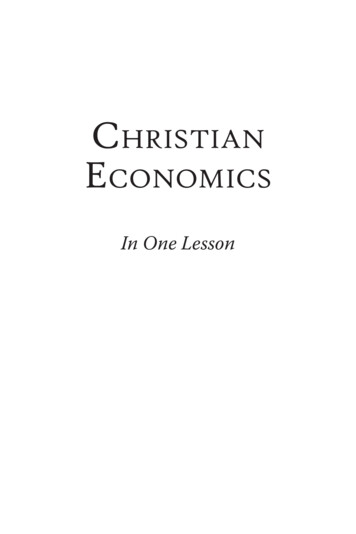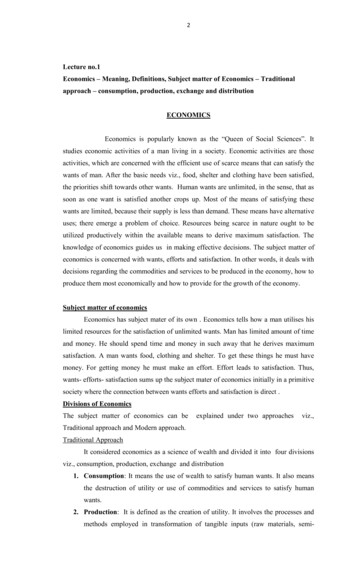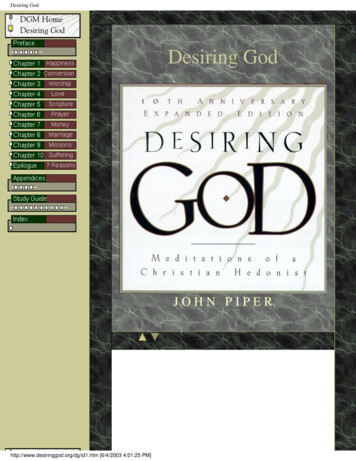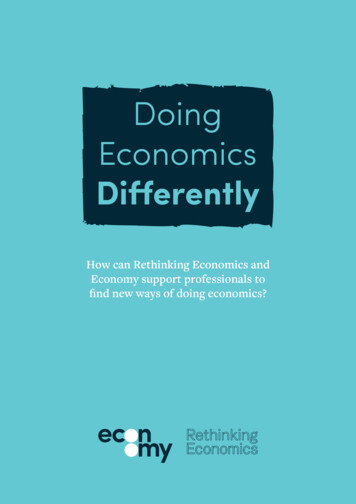
Transcription
ChristianEconomicsIn One Lesson
ChristianEconomicsIn One LessonGary NorthPOINT FIVE PRESSDallas, Georgia
Christian Economics in One Lessonby Gary North1st Edition, 20152nd Edition, 2020 Copyright by Gary North, 2015, 2020To buy a hardback copy of this book, go here:www.bit.ly/HardbackCE1Published by:Point Five PressDallas, GA 30157Printed in the United States of America.
This book is dedicated toRobert AndersonMy successor at FEE in 1973,who then carried the burden.
ContentsPreface .Introduction .ix.11:The Lesson .2:The Broken Window . . . . . . . . 193:The Blessings of Destruction .4:Public Works Mean Taxes .5:Taxes Discourage Production . . . . . . 496:Credit Diverts Production .7:The Curse of Machinery .8:Spread-the-Work Schemes .9:Disbanding Troops and Bureaucrats . 69. 85.9411:Who’s “Protected” by Tariffs? . . . . .10412:The Drive for Exports .11213:“Parity” Profits .14:Saving the X Industry .13015:How the Price System Works . . . . .13816:“Stabilizing” Commodities .17:Government Price-Fixing . . . . . .18:Minimum-Wage Laws . 16619:Do Unions Really Raise Wages? . 17320:“Enough to Buy Back the Product” . . . .77The Fetish of Full Employment .6010:.39. 31. 13. 119. 150160183
21:The Function of Profits .22:The Mirage of Inflation .23:Assault on Saving .24:The Lesson Restated . . . . . . .Conclusion .Appendix:Henry Hazlitt’s Enormous Contribution . 193. 200. 210.222232. 239
PrefaceYou have probably heard of Henry Hazlitt’s book, Economics in One Lesson.I do not think it is an exaggeration to say that this book,more than any other, has served as the single most important book in the revival of free-market economic thinking afterWorld War II. Among economists, F. A. Hayek’s The Road toSerfdom (1944) has been more important, but with respect tothe average man, who has probably never read Hayek’s book,Economics in One Lesson has been the touchstone.I was greatly blessed early in my career when Hazlitt tookan interest in me. He had worked closely with the Foundationfor Economic Education (FEE) from its beginning in 1946. Ijoined FEE’s staff in August 1971. I was 29. Harry, as he wascalled by his friends, went out of his way to encourage me.He analyzed the various government interventions in themarket by means of the metaphor known as “the broken window fallacy,” which is also known as “the things seen and thethings not seen.” The things not seen are the economic costsof the things seen: the most valuable uses for the moneyforegone. This metaphor had been devised in 1850 by theFrench journalist Frédéric Bastiat. This was Hazlitt’s one lesson in economics. This was the heart of Hazlitt’s book, and itworked in terms of economic analysis. Readers could followits logic.The Mises Institute bought the rights to make it availablefree of charge to anyone who wants to read it. You can download it here: http://mises.org/library/economics-one-lesson.ix
xChristian Economics in One Lesson1. Hazlitt’s AudienceWhen you think about when he wrote it, it is remarkablethat he was able to write it. It is even more remarkable that ithas sold as well as it has. He was given a leave of absence byThe New York Times in later 1945. He wrote every other dayfor 45 days. (http://bit.ly/hazlitt45days.)World War II had ended the previous August. President Truman had not yet removed wartime price and wage controls.He did that only under the pressure of what was basically arevolt by cattlemen in 1946 October. In October, he abolishedthe price controls on meat. In November, he abolished pricecontrols on wages and most commodities. The only price controls remaining after November were on sugar, rice, and rents.When Hazlitt wrote the book, residents of the United Stateshad been living under price controls for five years. Shortageswere a way of life. Rationing had been enforced duringtheentire period. The black market had flourished. So, Hazlitt included a chapter on price controls.Market by market, intervention by intervention, “brokenwindow by broken window,” Hazlitt wrote the book. It has 24chapters. He wrote every other day for six weeks. It was a major accomplishment. Given the enormous impact of the book,it was a startling accomplishment.But there is a major problem with the book, and this problem keeps getting worse. It is dated. It was written in 1946.He wrote it for a particular audience, and that audience wasstill living under the economic controls of World War II. Theissues that were prominent in the minds of his intended audience were not the same issues that are in the minds of voterstoday in the United States. Time marches on.The second problem with the book is this: Ludwig von Miseshad not yet written Human Action. That book was publishedin 1949. Hazlitt was a friend of Mises. Mises arrived in NewYork City in 1940, a refugee who had fled the Nazis. Hazlitthad read Socialism and The Theory of Money and Credit. Thesebooks had been published in Great Britain before World War
PrefacexiII. He had read Omnipotent Government and Bureaucracy,both published in 1944 by Yale University Press. But Mises’masterpiece was still in the future.There was a third problem. His audience was made up ofliterate people who had read his columns for years in The NewYork Times. He was also writing for businessmen. But he wasnot writing for people in the pews of America’s churches. Yet,from the point of view of the size of the audience, he misseda great opportunity. From the point of view of persuading amajority of Americans that government intervention in themarketplace is a bad idea, he had nothing to say. He did notappreciate the size of that audience, and he also had no familiarity with its terminology. He had been a protégé of H.L. Mencken, who was America’s most prominent skeptic inthe world of the intelligentsia. Mencken had chosen Hazlitt toreplace him as the editor of The American Mercury in 1933.Mencken was a self-conscious disciple of Frederick Nietzsche.This was not good training for someone writing a book to persuade a majority of America’s voters.Today, every one of the chapters in his book is still applicable in the United States. All of the interventions still exist. Some of them have faded in influence, such as the tradeunion movement, but all of them still have federal bureaucracies that interfere with the free market. His book did not persuade the masses to elect congressmen and senators, not tomention presidents, who were committed to rolling back theKeynesian administrative state. Things are a lot better thanthey were in 1946—outside of banking, anyway—but not because of Hazlitt’s book. Things began to get better in the fallof 1946, because there were political pressures on Truman toabolish the controls.It is one of those curious facts that Richard Nixon got hisstart in Washington during World War II as a bureaucrat withthe Office of Price Administration. So did the leftist economist, John Kenneth Galbraith. It was Nixon who, on August15, 1971, unilaterally imposed a comprehensive system of price
xiiChristian Economics in One Lessonand wage controls on the American economy. He did it by executive order. Those controls created major economic disruptions, and they were abandoned in 1974. But it is clear thatNixon never figured out the truths presented in Hazlitt’s book.He did not get over his faith in price and wage controls untilfirst-hand experience persuaded him that they were a bad idea.No book persuaded him of this.2. A New AudienceIn 2015, I decided that it was time for me to write a bookthat I had thought about writing ever since 1970: ChristianEconomics in One Lesson. I took each of Hazlitt’s chapters, andI rewrote them in terms of a fundamental Christian principle:thou shalt not steal.Hazlitt never identified the government interventions that hedescribes for what they really are, namely, theft. Hazlitt carefully avoided the fundamental ethical issue. He did not raisethe ethical question of who, exactly, had broken that famouswindow, and why. He analyzed what would happen after thewindow was broken, meaning after the government had intervened in the economy on behalf of some special-interest group.Hazlitt identified these groups, and he also identified what theirmotivation was: to feather their nests. But he did not straightforwardly identify the ethical impulse behind the breaking oftwo dozen windows. That was a strategic mistake.Here is a key problem. Hazlitt knew, as any instructor offreshman economics students knows, that most people cannot handle long chains of reasoning. They can barely handleshort chains of reasoning. Hazlitt used the fallacy of the broken window in order to help readers follow a relatively shortchain of reasoning. That was as much as he could expect toaccomplish. The book achieved this.There is a secondary problem even with short chains of reasoning. They may persuade minds, but they do not mobilizethe troops. People only rarely re-think their lives, and thenre-dedicate their lives, on the basis of a short chain of rea-
Prefacexiiisoning. The immediate benefits of re-thinking your presuppositions are minimal, and the costs are high. If people reallydo act in terms of their personal self-interest, as economistsargue, then only a few of them are going to re-structure theirlives on the basis of the application of the metaphor of a broken window.If, on the other hand, you can persuade the person that he hasbecome an accessory, or even an active participant, in breakingsomebody else’s window, you may be able to gain his attention.You may be able to motivate him by a careful consideration ofthis principle: thou shalt not steal. If you move the discussionfrom economic analysis to ethical analysis, you up the antedramatically. If you move the discussion from a considerationof Adam Smith’s invisible hand to an invisible God with a rodof iron, you are more likely to catch people’s attention. Anyway,you are more likely to catch the attention of millions of peoplewho spend Sunday morning sitting in pews.3. The Social GospelBeginning in the 1880’s, a movement known as the socialgospel began to have influence in the United States. This movement was developed by liberal theologians who had adoptedwelfare state economics. In the name of Jesus and Christianity, they came before educated Christians and pastors, persuading them to adopt welfare state principles and policies inthe name of the Bible. This movement became a major intellectual force in the mainline denominations after World WarI. Some variant of the social gospel still is dominant in all ofthe mainline Protestant denominations. In the form knownas liberation theology, it is dominant in the Roman CatholicChurch. The present Pope is a liberation theologian. It was apowerful influence in his life as a priest in Argentia.The social gospel movement did not appeal to SouthernBaptists, fundamentalists, and most adherents of what hasbecome known after World War II as the new evangelicalism.But there have been promoters of the social gospel, which is in
xivChristian Economics in One Lessonfact a statist gospel, within the camp of the evangelicals. Themost prominent one today is Jim Wallis. I have a departmentrefuting Wallis on GaryNorth.com.In the late 1970’s, the most prominent figure was RonaldSider, who wrote Rich Christians in an Age of Hunger (1977).I hired David Chilton in 1980 to write a refutation. I believehis book is the most rhetorically powerful response to thesocial gospel ever written: Productive Christians in an Age ofGuilt-Manipulators. (I provided the money and the title.) Youcan download it here: www.bit.ly/chilton-sider.In the 1990’s, the most influential figure was Tony Campolo, a professor of sociology. He lost some influence after theMonica Lewinsky scandal broke in 1998, because he had beena spiritual advisor to Bill Clinton. But he continued speakingat 200 conferences a year until he retired in 2014.4. Beating Something with NothingI have understood this political principle for all of my adultlife: “You can’t beat something with nothing.”Free market economists have attempted to overcome the influence of welfare state economics by means of careful discussions of the economic inefficiency of welfare state economies.But people who are profiting from welfare state programs arenot impressed. They believe that they come to the voters froman elevated position. They believe that they occupy the moralhigh ground.Free-market economists assume that economics is valuefree. They never come in the name of the moral high ground,because they believe that, in economic affairs, there is no moral high ground. There is no morality at all. They see the economic public square as a playing field having to do only withpersonal liberty and economic efficiency. Because of this, theyhave lost the case. Most people don’t vote in terms of economic efficiency. They may vote in terms of personal liberty, butonly in those cases in which somebody else has persuaded thegovernment to invade to their personal liberty. They vote to
Prefacexvdefend themselves from tyranny. Then they turn around andvote to impose tyranny on someone else. They do this in thename of the moral high ground.What we need is a systematic economic approach that persuades people in the pews that the adoption of welfare stateprinciples and policies is a violation of the commandment notto steal. It is crucial that those people who favor the free market are in a position to persuade those who occupy the pewsthat the latters’ commitment to welfare state policies, Keynesian redistribution policies, and special-interest legislation is aviolation of the commandment not to steal. This is what Misesrefused to do, Hayek refused to do, Friedman refused to do,and, sadly, Hazlitt refused to do.I decided to do it. I have a tremendous advantage. I readHazlitt’s book and Human Action by the time I was 21. I alsoread Rothbard’s Man, Economy, and State (1962). That was in1963. I had a head start on Hazlitt, because Hazlitt had donehis work in 1946. The old line about standing on the shouldersof giants is accurate.The average man in the pew has never heard of Hazlitt, Mises, or Rothbard. But he has heard this: “Thou shalt not steal.”This is where I start. Along the way, I take readers on a tour oftwo dozen broken windows. After this, I will encourage readers to stop voting for politicians who throw stones at windowsin the name of justice and the high moral ground.Support materials for can be found in the “Further Reading”section at the end of each chapter, where applicable.Further ReadingFor support materials go to bit.ly/CEIOL-Doc-Preface.
IntroductionChristian Economics in One Lesson is my reworking ofHenry Hazlitt’s classic introduction to economic thought,Economics in One Lesson. That book set the standard as anintroductory economics book. Nothing has come close to replacing it ever since it was first published in 1946.Why do I believe it is necessary to replace a classic? Thereare several reasons. First and foremost, it was written in 1946.A lot has happened since then, including the publication ofLudwig von Mises’ Human Action (1949). Second, it was written under a strict deadline. Hazlitt had been given a six-weekleave of absence, and he had to produce the book from startto finish. It is possible to do this. I have written several booksin less than a month. I wrote my introductory book on Christian economics, Inherit the Earth (1987), in two weeks. But Ihad a tremendous advantage at the time, which a year earlier Iwould not have enjoyed. I had a structure, as I explain below.Hazlitt did not have a comparable structure. This made hiswork more difficult, and it made the book less effective than itmight have been. Third, he targeted a different audience: readers of his business columns. I target Christians. (OrthodoxJews are invited to come along for the ride.) Fourth, I placeethics at the heart of my analysis: the deliberate breaking ofthe window. Hazlitt did not—not explicitly, anyway.1. The Broken WindowHe began the book with a classic metaphor: Frédéric Bastiat’s broken window. It was a powerful analytical tool when1
2Christian Economics in One Lessonit was first published in 1850, the year the author died. It waslong ignored by professional economists, probably becauseBastiat was perceived by them as a journalist at best. Everyoneknew that he was a gifted essayist and a master of rhetoric—the art of persuasion. But his essays were never accepted bywriters in the field of what was then called political economy.By the time that economics developed as a separate academicfield after 1900, he was forgotten.Then came Hazlitt’s book. Hazlitt resurrected Bastiat’s brilliant metaphor, and then he applied it, chapter by chapter,state intervention by state intervention. He demonstrated theanalytical power of the original observation. The fundamentalinsight of Bastiat was this: the typical observer of economicaffairs is blinded by the visibility of the effects of spending. Hedoes not think to investigate what else could have been donewith the money. This insight has become the most commondefinition of economic cost: the most valuable use forgone because a buyer spends the money on something else. Anyonewho wants to demonstrate economic logic can do no betterthan to invoke the broken window metaphor.Every economic decision is something of a broken window.It is the substitution of a new set of conditions for an older setof conditions. Maybe we do not break the old window, but weexchange it for something we think will be better. We come toforks in the road, decision by decision. Once we take a particular fork in the road, we can never return to exactly the samefork. Our world changes at the margin. It changes because ofthe decision we made. So, when we think of the cost of anydecision, we should always think of it as a decision to go downone road rather than another. We spend our money and wespend our time on one thing, and therefore we cannot spendit on another. That other thing is our cost.Because public works projects were popular in France in1850, and everywhere else, Bastiat’s observation helped makeit possible to come to grips with the real costs that are borneby individuals and societies when violence is used against a
Introduction3property owner. Just because the government is the violator,this in no way changes the economic analysis of the replacement costs of the broken window.The power of the metaphor is simple, for this reason: wecan understand it. It does not involve a long chain of reasoning. We find it difficult to follow long chains of reasoning,and economic analysis, more than any other social science,usually involves long chains of reasoning. People get lostalong the way. Also, as the reasoning becomes more complex, people’s commitment to the details of the chain of reasoning grows weaker. If it is necessary to argue a point insuch a way that not a single link in the chain is left out ormisapplied, then the outcome of the chain of reasoning isnot clear, either to the person making the argument or to theperson who is listening carefully—initially—and attemptingto follow it. The longer the argument, the less its persuasivestrength. People get bogged down in the details. They cannot keep the details straight. If you cannot keep the detailsstraight, you cannot be confident that you have gone frompoint A to point Z in a systematic and accurate way.Making effective use of the metaphor of the broken windowinvolves pointing to only a couple of short chains of reasoning. There are more chains, and they can be long, but you don’tneed to follow all of them in order to make your point. Mostpeople can follow this chain, and one of the reasons why theycan follow it is the simplicity of the metaphor. We can understand a broken window. We can understand the economicburden of replacing that window. We do not get bogged downin a long chain of reasoning.This is why Hazlitt’s book was a success. Bastiat did notmake it work in his lifetime. He died in the year he came upwith it. A century later, Henry Hazlitt made it work.My book is not an attempt to reinvent the wheel. My book isan attempt to re-balance the wheel, stick a new tire on it, andsell it to a new audience.
4Christian Economics in One Lesson2. I Begin With OwnershipI believe that Christian economics must begin with the issueof ultimate ownership. This sets it apart from modern economic analysis, which begins with the issue of scarcity. Second, this leads to the issue of theft, which in turn raises theissue of ethics.I believe that the ultimate form of causation in human history is ethical: right vs. wrong. Modern economists do not sharemy view. It goes beyond this. They openly reject it. They proclaim economic analysis as value-free. I regard this as self-deception. It is a variation of an ancient temptation: “Hath Godsaid?” Yes, He has. “Thou shalt not steal.” There are negativesanctions attached to this commandment. These negativesanctions are both endogenous (inherent in the economy) andexogenous (imposed by God on the economy).A. Adam Smith’s Strategic ErrorI come now to a crucial point. I am not the first person tomake this point; Tom Bethell is. He did this in Chapter 7 ofhis book, The Noblest Triumph (1998). Adam Smith beganwith scarcity as the heart of his economic analysis: the famousthird chapter in The Wealth of Nations (1776). This was on thedivision of labor/specialization. He set the pattern for subsequent economic theorists.Smith should have started with ownership. He should havemade private ownership the bedrock foundation of his analysis. By beginning with the division of labor, he committed astrategic error. Critics from the Left immediately challengedhim. They were also able to invoke the division of labor. Theyinvoked state planning as a way to deal with the problems ofcoordinating the division of labor. This was Bethall’s argument.The fundamental economic issue, ownership, did not become a major focus of economic theory until the 1950’s. So,for almost two centuries, the crucial economic issue had notbeen central in free market economic analysis.
Introduction5B. Bastiat’s Two EssaysIn 1850, the year of his death, Bastiat wrote a long essay,“That Which is Seen, and That Which is Not Seen.” In it, heoffered a metaphor: the broken window. Someone throws astone through another man’s window. That man must now replace his window. He will have to hire a window repairman,who in turn will have to hire others. The broken window hastherefore led to greater spending. The economy benefits.Yet the victim experienced a loss. How can good come outof bad? How can a destructive act produce wealth? This wasa paradox that confronted Bastiat. He solved it brilliantly. Theowner of the window had other uses for his money. These heregarded as better uses. He either would have saved his moneyor else he would have spent it on other things besides a newwindow. In either case, the economy would have benefitted.Other producers would have benefitted. This, Bastiat said, isthat which is not seen. The spending on the new window iswhat people see. In short, “follow the money.” Follow the money backwards: back to what he would have done, had not anenvy-driven person tossed a stone through that window.This is a strategy of economic analysis. Bastiat ended his essay by quoting a French author.I might subject a host of other questions to the sametest; but I shrink from the monotony of a constantly uniform demonstration, and I conclude by applying to political economy what Chateaubriand says of history:—“There are,” he says, “two consequences in history; an immediate one, which is instantly recognized, and one in the distance, which is notat first perceived. These consequences oftencontradict each other; the former are the resultsof our own limited wisdom, the latter, those ofthat wisdom which endures. The providentialevent appears after the human event. God rises
6Christian Economics in One Lessonup behind men. Deny, if you will, the supremecounsel; disown its action; dispute about words;designate, by the term, force of circumstances,or reason, what the vulgar call Providence; butlook to the end of an accomplished fact, and youwill see that it has always produced the contraryof what was expected from it, if it was not established at first upon morality and justice” (Chateaubriand’s Posthumous Memoirs).There is a second fact, even more crucial to my book, butnot for Hazlitt’s: the issue of ethics. Bastiat wrote another essay in 1850: The Law. In that essay, he turned to ethics, namely, the issue of theft. He described the welfare state. He alsoidentified its underlying motive. He called this the politics ofplunder. He wrote:The Fatal Idea of Legal PlunderBut on the other hand, imagine that this fatal principle has been introduced: Under the pretense of organization, regulation, protection, or encouragement,the law takes property from one person and gives itto another; the law takes the wealth of all and gives itto a few—whether farmers, manufacturers, ship owners, artists, or comedians. Under these circumstances,then certainly every class will aspire to grasp the law,and logically so.The excluded classes will furiously demand their rightto vote—and will overthrow society rather than not toobtain it. Even beggars and vagabonds will then proveto you that they also have an incontestable title to vote.They will say to you:“We cannot buy wine, tobacco, or salt without paying the tax. And a part of the tax that we pay is given
Introduction7by law—in privileges and subsidies—to men who arericher than we are. Others use the law to raise the prices of bread, meat, iron, or cloth. Thus, since everyoneelse uses the law for his own profit, we also would liketo use the law for our own profit. We demand from thelaw the right to relief, which is the poor man’s plunder.To obtain this right, we also should be voters and legislators in order that we may organize Beggary on agrand scale for our own class, as you have organizedProtection on a grand scale for your class. Now don’ttell us beggars that you will act for us, and then tossus, as Mr. Mimerel proposes, 600,000 francs to keep usquiet, like throwing us a bone to gnaw. We have otherclaims. And anyway, we wish to bargain for ourselvesas other classes have bargained for themselves!”And what can you say to answer that argument!Perverted Law Causes ConflictAs long as it is admitted that the law may be diverted from its true purpose—that it may violate propertyinstead of protecting it—then everyone will want toparticipate in making the law, either to protect himselfagainst plunder or to use it for plunder. Political questions will always be prejudicial, dominant, and all-absorbing. There will be fighting at the door of the Legislative Palace, and the struggle within will be no lessfurious. To know this, it is hardly necessary to examinewhat transpires in the French and English legislatures;merely to understand the issue is to know the answer.Bastiat based his analysis on the issue of ethics: a refusal touse the state for the purpose of plunder. He wrote:This question of legal plunder must be settled once andfor all, and there are only three ways to settle it:
8Christian Economics in One LessonThe few plunder the many.Everybody plunders everybody.Nobody plunders anybody.To understand correctly Bastiat’s essay on the thing notseen, we must understand its connection to his idea of thestate acting as an agency of plunder. He grounded his analysis of the economics of the broken window in terms of hisbroader concern: to persuade people not to adopt the politics of plunder.He took a stand against the modern welfare statist’s rewriting of God’s commandment, “Thou shalt not steal.” Theyhave revised it as follows: “Thou shalt not steal, except bymajority vote.”C. Hazlitt’s Partial Use of BastiatWe now return to Hazlitt’s book. Hazlitt, following the leadof Bastiat, began with a violation of private property: the broken window. This act is a violation of ownership, but Hazlittdid not focus on the rights of ownership. In other words, hedid not begin with the fundamental economic issue: “Who islegally responsible for the allocation of property, and why?”But there was a fundamental difference in Hazlitt’s approach.He did not ground his criticism of state intervention in termsof ethics. He limited his use of the metaphor of the brokenwindow to this: a refutation of state intervention as the basisof economic growth.Both men began with a negative sanction: throwing a stonethrough a window. This is a violation of property rights, butthey never mentioned property rights. Had they done so, thiswould have raised the issue of ownership.Then they followed the money. They showed that the ownerhad to re-allocate his financial budget to replace the brokenwindow. Already, he was a loser. That was because he was avictim of a violent invasion of his rights of ownership.Bastiat in The Law extended his critiques of state interven-
Introduction9tionism that he presented in his essay on the thing not seen.His criticism of the state in the essay was not grounded in morality. He merely traced the economic causes to their effects:a forced redistribution of wealth. Hazlitt picked up on thistheme, but he did not adopt Bastiat’s ethics-based refutationof state intervention, which he presented in The Law.This is a fundamental difference between my book and Hazlitt’s. I return to Bastiat’s ethics-based analysis in The Law.I begin with ownership. Specifically, I begin with God’s ownership of all things. Men’s ownership is delegated ownership.It is inherently a form of stewardship. This is a multi-
ou have probably heard of Henry Hazlitt’s book, Econom-ics in One Lesson. I do not think it is an exaggeration to say that this book, more than any other, has served as the single most import-ant book in the revival of free-market economic thinking after











